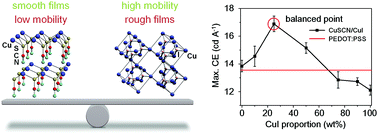Copper thiocyanate/copper iodide based hole transport composites with balanced properties for efficient polymer light-emitting diodes†
Abstract
The realization of hole transport materials (HTMs) with balanced properties is challenging. We address this challenge by merging inorganic copper thiocyanate (CuSCN) and copper iodide (CuI) into a composite, and balancing their hole-transport and surface-morphology properties through adjusting the CuI:CuSCN proportion. The advantages of both CuSCN and CuI are brought into play, including the controlled crystalline growth suppressed by the thiocyanate ion (SCN−) and the high mobility provided by CuI, thus yielding a cheap, stable, solution- and low-temperature processed HTM with a high transparency and mobility, suitable energy level and smooth surface morphology. The favourable balance is achieved at the CuI proportion of 25 wt%, which affords superior performances with maximum luminance and average current efficiency values of 147 000 cd m−2 and 16.8 cd A−1 for Super Yellow based polymer light-emitting diodes, 134% and 27% higher than that of a PEDOT:PSS based control device, respectively. Our results fulfill the expectation for a HTM with a good trade-off between interface characteristics and optoelectronic properties, providing a pathway for significant applications of inorganic HTMs in organic electronics, such as solar cells and thin-film transistors.



 Please wait while we load your content...
Please wait while we load your content...